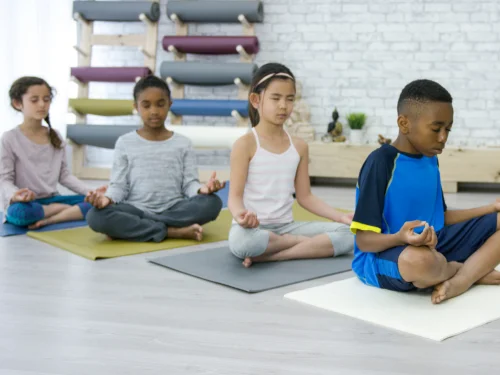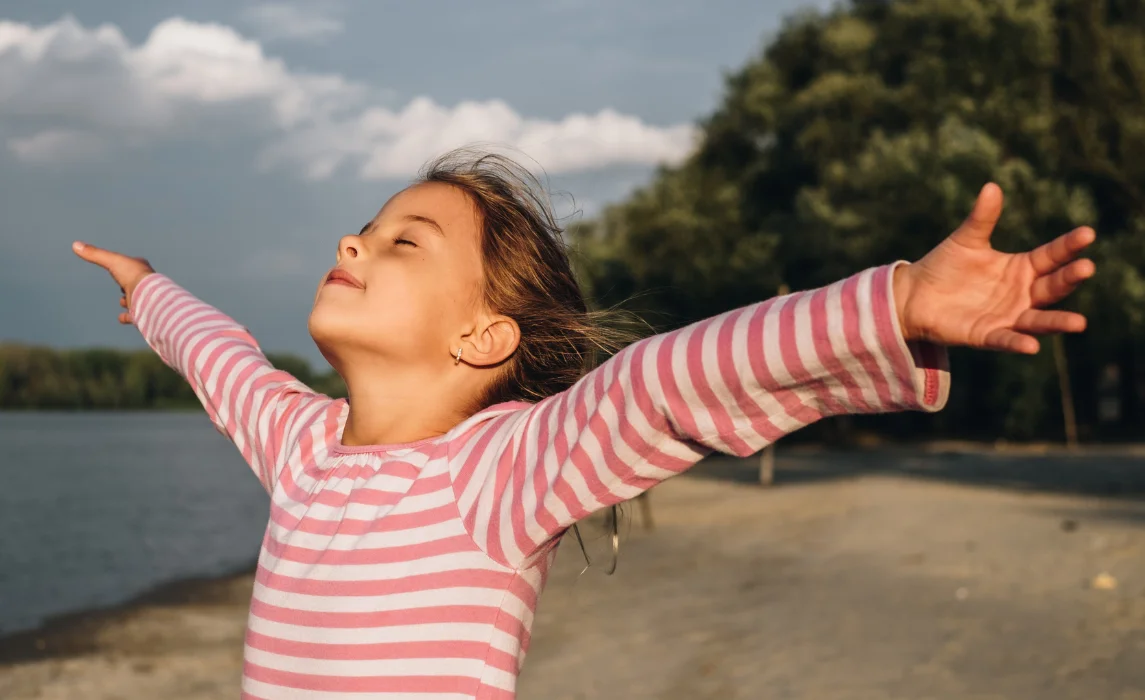15 Mindfulness Activities for Kids: Simple Ways to Build Calm, Focus, and Emotional Strength

Yes—finger plays, clapping games, and dance routines that use hand gestures all help. Combine rhythm and repetition for deeper learning.
Send home simple activity ideas, kits, or worksheets. Offer short instructions and encourage family involvement. Regular practice builds lasting progress.
Try origami, sticker scenes, stringing pasta, or painting with Q-tips. Crafts that use small pieces build precision and control.
In today’s fast-paced world, even children feel the pressures of busy routines, constant stimulation, and emotional overwhelm. The good news? Mindfulness—a simple practice of staying present and aware—can help kids manage these challenges with more calm, confidence, and clarity.
Whether at home, in the classroom, or during playtime, introducing mindfulness can have lasting benefits on children’s emotional regulation, attention span, and overall well-being
What Is Mindfulness for Kids?

Mindfulness is the practice of focusing one’s attention on the present moment with curiosity and kindness—without judgment. For kids, it means learning to notice their thoughts, feelings, body sensations, and surroundings in a calm and intentional way.
Why Mindfulness Matters for Children
.webp)
Research shows that mindfulness can:
- Improve emotional self-regulation and reduce outbursts.
- Boost focus and concentration in academic and everyday tasks.
- Lower stress and anxiety levels.
- Increase empathy and social connection.
- Support mental well-being and resilience.
It’s especially helpful for children with ADHD, anxiety, or learning difficulties—but every child can benefit.
15 Fun and Effective Mindfulness Activities for Kids
.webp)
These child-friendly activities offer playful, age-appropriate ways to introduce mindfulness through movement, breath, observation, and creativity.
1. Finger Breathing
Children trace the outline of one hand with a finger from the opposite hand. As they go up each finger, they breathe in; as they go down, they breathe out. This tactile breathing exercise is calming and easy to remember.
2. Spidey Senses
Inspired by superheroes, kids activate their five senses to notice what they can see, hear, smell, feel, and taste in the moment—just like Spiderman being alert to his surroundings.
3. Mindful Glitter Jar
Shake a glitter jar and watch as the sparkles slowly settle. This visual metaphor helps kids understand how their thoughts and emotions calm with stillness.
4. Belly Breathing with a Stuffed Animal
Have your child lie down with a small stuffed toy on their belly. As they breathe in and out, they can watch it rise and fall—teaching breath awareness in a comforting way.
5. Square Breathing
Guide children to breathe in for four counts, hold for four, exhale for four, and pause for four. You can draw a square with your finger in the air to help them visualize it.
6. Mindful Walk or Safari
Take a walk outdoors and challenge children to spot five different textures, shapes, animals, or colors. This encourages grounded, intentional observation of their environment.
7. Magic Mandalas
Let kids create their own mandalas using crayons, natural materials, or simple coloring pages. Repetitive, symmetrical patterns offer a soothing and meditative focus.
8. Heartbeat Check
After brief physical activity, have children sit quietly with their hand on their chest and feel their heartbeat slowing. It’s a way to connect with the body and calm down.
9. Mindful Eating
Give each child a small piece of food—like a raisin or a slice of apple—and guide them to observe its look, feel, smell, taste, and even sound while chewing. This helps build patience and sensory awareness.
10. Emotion Weather Report
Ask, “What’s the weather like inside you today?” Children can describe their emotions using weather terms (sunny, cloudy, stormy), helping them name and normalize feelings.
11. Be the Pond
Teach kids to think of their mind as a pond, and their feelings as fish swimming in it. The pond stays still, letting thoughts and feelings come and go.
12. Five Senses Check-In
Ask kids to pause and notice:
- 5 things they can see
- 4 they can feel
- 3 they can hear
- 2 they can smell
- 1 they can taste
It’s a quick way to return to the present moment.
13. Guided Visualization
Lead a short meditation where kids imagine a calm place—like a beach, forest, or their own “happy island.” Describe the sights, sounds, and feelings to activate imagination and soothe anxiety.
14. Mindful Movement or Yoga
Use simple poses (like Tree, Mountain, or Butterfly) combined with breathing to connect mind and body. YouTube channels like Cosmic Kids make it fun and accessible.
15. The Magic Worry Box
Invite kids to write down their worries and place them in a decorated “worry box.” This symbolic act of letting go encourages emotional release and reflection.
You May Also Like: 8 Powerful Benefits of Writing: Why Putting Pen to Paper Still Matters—Especially for Kids
Mindfulness Tips for Parents and Educators
.webp)
- Start small. One or two minutes is enough for beginners.
- Practice together. Children learn best when adults model the behavior.
- Be consistent. Build mindfulness into daily routines—before bedtime, during transitions, or after recess.
- Validate feelings. Mindfulness isn’t about avoiding emotions, but noticing them with kindness.
- Use stories and play. Make it imaginative, visual, and sensory-based.
You May Also Like: How to Tell If You Have Astigmatism: 5 Key Symptoms and Diagnostic Tips
Final Thoughts
.webp)
Mindfulness isn’t about quieting the chaos—it’s about teaching kids how to notice it and respond with awareness. Through simple practices and consistent encouragement, children can develop the tools they need to handle big emotions, focus better, and build resilience for life.
Whether you’re a teacher, parent, or therapist, incorporating mindfulness into a child’s day can create calm moments—and lifelong impact.
You May Also Like: Can You Use Soap on Cast Iron? The Truth About Cleaning Your Cast-Iron Skillet and Skillets
Frequently Asked Questions (FAQ)
1. What age can children start practicing mindfulness?
Kids as young as 3 or 4 can begin simple mindfulness activities like breathing with a stuffed toy or noticing their five senses. The key is to keep sessions short, fun, and playful.
2. How does mindfulness help with focus and attention in kids?
Mindfulness teaches children to notice when their minds wander and gently bring their focus back. Over time, this strengthens attention spans and supports better concentration in school and daily tasks.
3. Can mindfulness reduce anxiety in children?
Yes. Research shows that mindful breathing, visualization, and grounding techniques can lower stress hormones, helping kids manage anxiety and emotional overwhelm in healthier ways.
4. What are some quick mindfulness activities for the classroom?
Teachers can try “1-minute breathing breaks,” “Spidey Senses,” or a “Mindful Moment Bell.” These short practices help reset energy and improve classroom focus without disrupting lessons.
5. How often should kids practice mindfulness?
A few minutes a day is enough to see benefits. Consistency matters more than duration—try including mindfulness during morning routines, after school, or before bedtime.
6. What if my child can’t sit still during mindfulness activities?
That’s normal! Choose movement-based activities like yoga, mindful walking, or stretching. The goal is awareness, not stillness—children can learn mindfulness through active play, too.
7. How can mindfulness help children with ADHD or emotional regulation issues?
Mindfulness supports self-regulation by helping kids pause before reacting. It strengthens the brain’s “focus and calm” centers, improving impulse control and emotional balance over time.
8. Are there mindfulness activities that don’t require meditation?
Absolutely. Many child-friendly options like mindful coloring, the glitter jar, or emotion weather check-ins build mindfulness without formal meditation or silence.
9. How can parents encourage mindfulness at home?
Model calmness yourself, practice mindful breathing together, and weave it into everyday moments—like brushing teeth, eating, or going for walks. Kids learn best by watching you.
10. What’s the main goal of teaching mindfulness to kids?
The goal isn’t perfection or constant calm—it’s helping children recognize their thoughts and emotions with kindness, build focus, and respond to life’s challenges with confidence and empathy.



